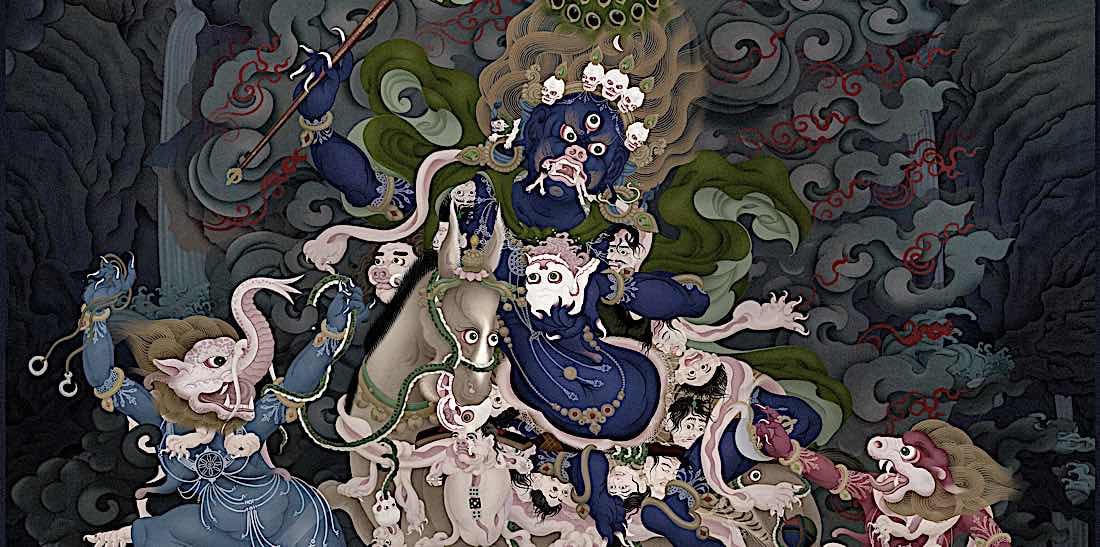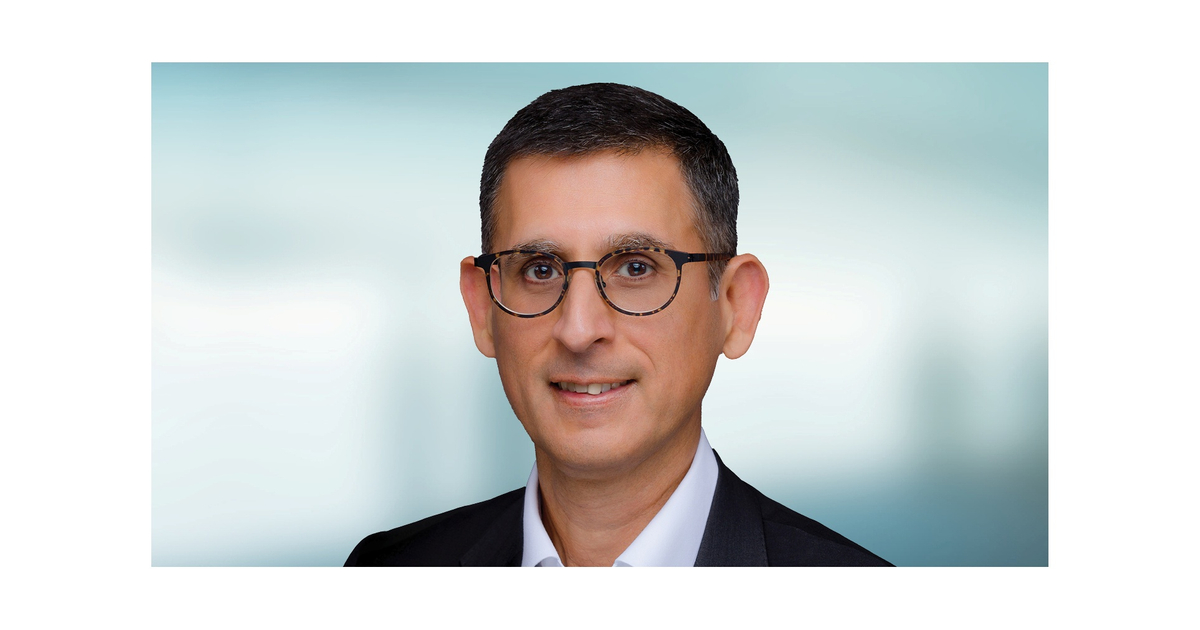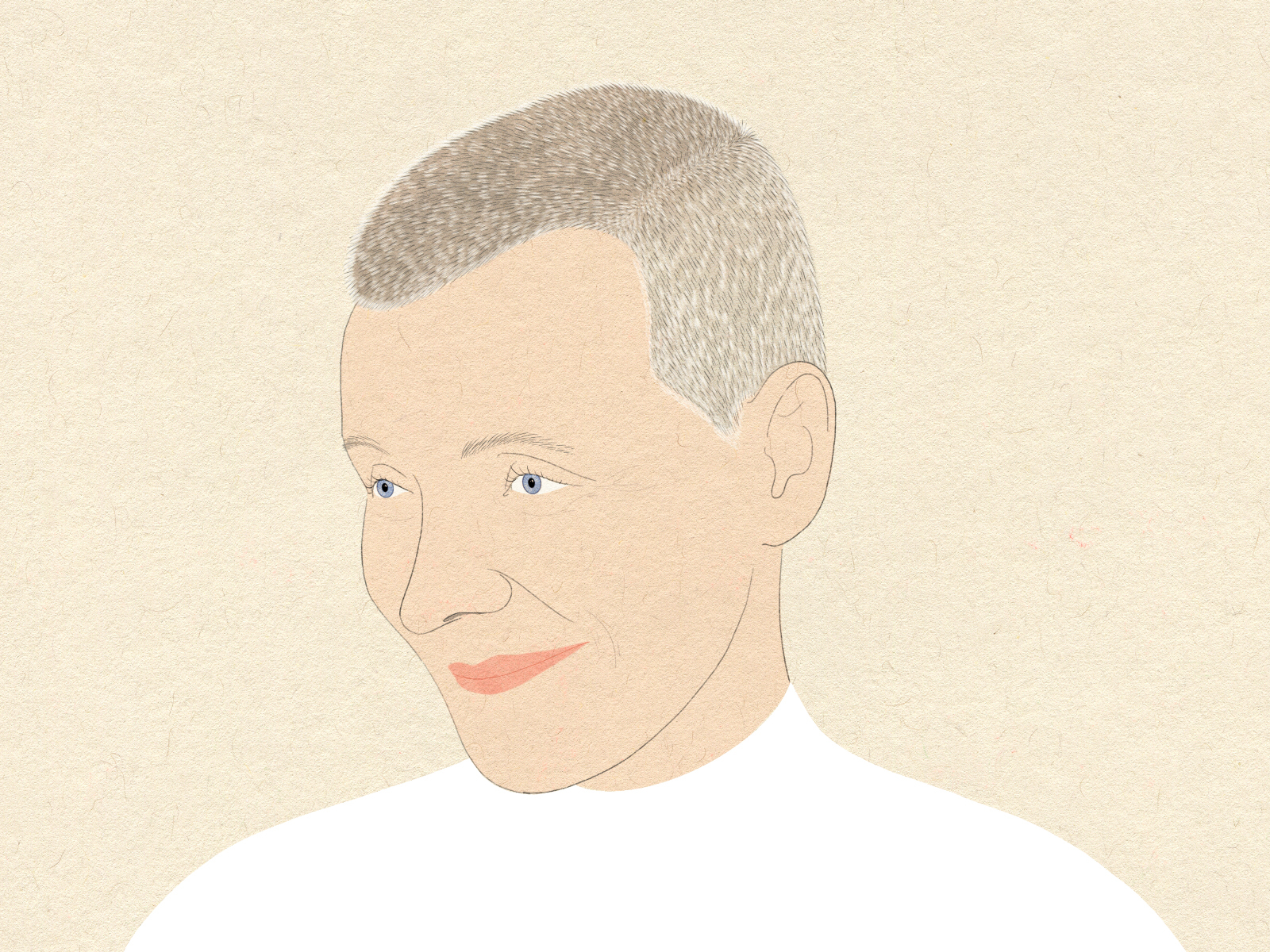Moving Beyond Meditation
Grounded in our formal practice of meditation, we can relax into the vast, open awareness that is our ultimate nature. Yongey Mingyur Rinpoche tells the story of his own introduction to the Great Perfection. The post Moving Beyond Meditation...
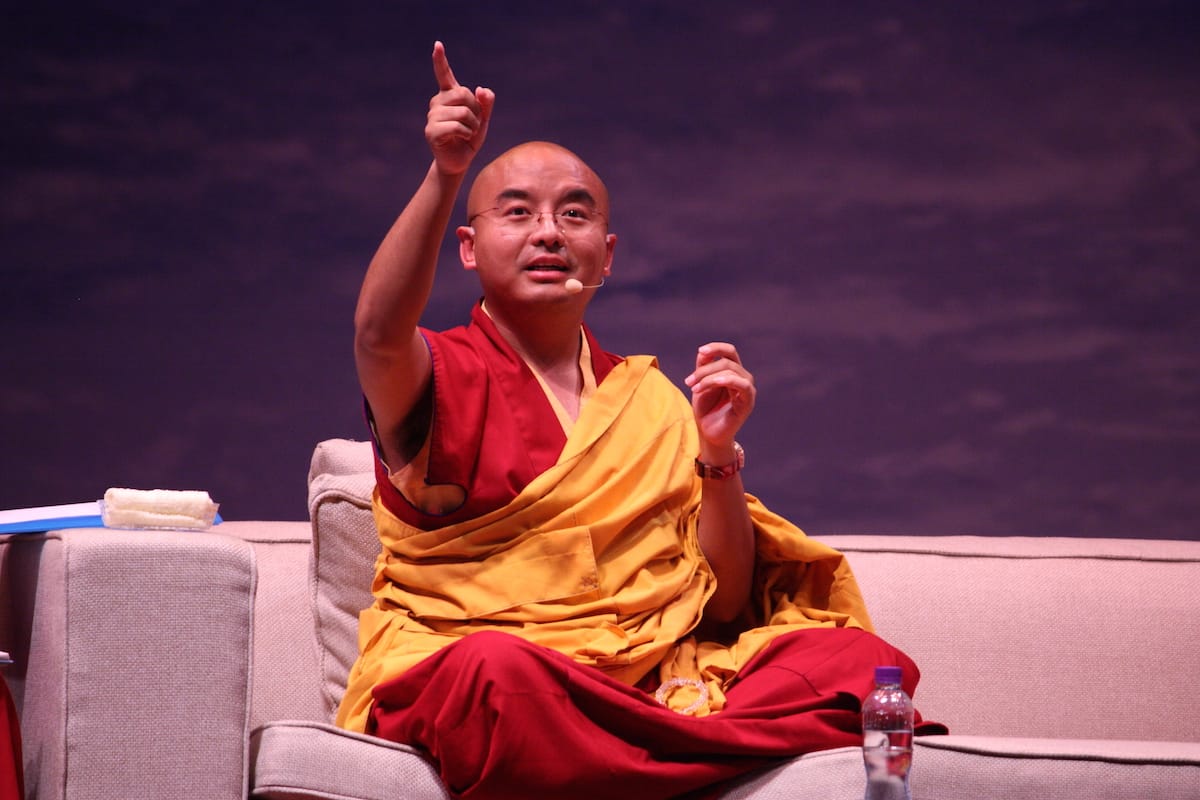
My introduction to the world of the Great Perfection (Dzogchen in Tibetan) occurred when I was just a small boy. The first years of my life were spent in my mother’s village near the border of Tibet and Nepal. I haven’t been back there since I was young, but I vividly remember the massive snow-capped mountains that towered above us on all sides and the flower-filled meadows that stretched out along the valley floor surrounding our village. Looking from the outside, you would think that I was born with a charmed life. I lived in one of the most beautiful and serene places on Earth, surrounded by people who loved me dearly. The elders of both sides of my family, moreover, were renowned spiritual teachers, so from the time I can remember I was exposed to the practice of meditation and its power to transform the mind.
Despite these idyllic surroundings and the deep bonds I shared with my family, my charmed life took a turn for the worse one year. When I was about seven years old, a deep, consuming sense of dread began to take over my being. I couldn’t figure out what was happening to me or why. All I knew was that even the simplest things—like a thunderstorm or the arrival of a stranger—could throw my mind into a tailspin. Fear would well up from the pit of my stomach and terrifying thoughts would crowd my mind, leaving me paralyzed with the feeling that something terrible was about to happen. This difficult period provided me with a powerful motivation to explore my mind and feelings. Though I didn’t know much about meditation at the time, I had a vague sense that it could help me deal with my anxiety. For a while I tried to meditate on my own, but aside from a few fleeting moments of inner peace, the feeling of dread continued to follow me like a shadow.
Most winters my mother and I would travel from our village in the mountains to Kathmandu, where we would spend six months with my father, the great meditation master Tulku Urgyen Rinpoche. Yap Rinpoche, as I affectionately called him, lived in a small hermitage on the outskirts of the Kathmandu Valley, where he taught his unique style of effortless meditation to students from all over the world. In the mornings, the monks and nuns from his hermitage would come to receive teachings about meditation or the rituals of Tibetan Buddhism, and in the evening he would teach his non-Tibetan students. I would often sit quietly to the side and listen as he taught.
Though I didn’t really understand much of what he said, I yearned for the calm serenity that he radiated. At first I was so timid that I couldn’t muster the courage to ask him to teach me about meditation, but after a while my anxiety became so intense that it overrode my shyness. I still couldn’t ask my father directly, though, so I begged my mother to make the request on my behalf. I was overjoyed when she told me the news that he had agreed to teach me.
At the same time as I was beginning to meditate, I was learning how to read and write. In the afternoons I would sit with my father in his meditation room, which had a huge window that looked out over the entire valley. As part of his daily practice, he chanted a text called The Precious Treasury of the Basic Space of Phenomena, which is considered one of the most elegant works on the Great Perfection, the most profound and treasured teachings of my father’s lineage. My father used this text to teach me how to read. As we sat together in his small hermitage, he would sing the words of the book to me in a beautiful melody and ask me to repeat after him. I would then do my best to imitate him, and eagerly wait for his approval. At the time, I thought he was just helping me learn to read, but looking back I can see that he was actually introducing me to the ground, path, and fruition of the Great Perfection.
The Ground of the Great Perfection
You might think that the hours I spent learning to sing the words of the Precious Treasury would eventually sink in, but I really had no idea what they meant. To me, the book was just a bunch of weird terms that didn’t mean a thing, but I liked it because of the soothing melody that my father used when he sang it to me. One day, as we sat together in his room chanting and meditating, I noticed a word that I’d heard my father say many times when he taught his students. “What does this word mean,” I asked, pointing to the Tibetan word ka dak.
“Oh, that’s a very important term,” he replied, pleased to see my interest. “Do you remember what I told the students last night about the mind’s true nature?” The truth was that I didn’t understand much of what he said when he taught, so I looked down and shook my head in embarrassment.
Seeing my reaction, he patted me gently on the shoulder and said, “There’s no need to feel embarrassed. When I was young I had to learn the meaning of all these words just like you.” He then paused for a moment and looked at me with such affection that all my fear and embarrassment dissolved. “What I taught the students last night is that our true nature is completely pure and good. The word you asked about, ka dak, means ‘pure from the very beginning.’ It might not always seem like this is the case, but there isn’t the slightest bit of difference between your true nature and the Buddha’s. In fact, even an old dog has this original purity.”
“What does purity mean?” I asked.
“Purity means that our true nature is already perfect and complete,” he continued. “None of our confusion and fear can change this inner purity. It doesn’t get worse when we suffer or improve when we become enlightened like the Buddha. We don’t need to add anything to it or take anything away, nor do we have to do something to get it. It’s here with us each and every moment, like a diamond in the palm of one’s hand.”
“If our true nature is so wonderful,” I asked, “then why do we suffer?”
“That’s a good question,” he answered. “The problem isn’t that we need to get something that we don’t already have, or that we have to get rid of all the things we don’t like. The Buddha can’t magically appear and take away all our suffering and confusion. The problem is that we don’t recognize what we’ve had all along. We get so caught up in the drama of our lives that we don’t see the radiant purity of our very own minds. This nature is with us even when we feel scared, lonely, and angry.”
I looked up at my father’s kind face as he spoke these words and a feeling of tremendous love and respect welled up from deep within me. I still didn’t fully grasp what he was trying to teach, but I started to open to the possibility that there was more to life than all the thoughts and feelings that crowded my young mind. What he had just introduced me to was the ground of the Great Perfection, the inner reality that we discover on the spiritual path.
The Path of the Great Perfection
With this newfound confidence, I continued to meditate on my own. Though I still didn’t have a direct experience of what my father was trying to teach me, I soon found that by focusing my mind on something, I could experience a glimpse of tranquility. Despite this development, I still thought of meditation as something that would help me get rid of the parts of myself that I didn’t like. I sincerely hoped that meditation would lead me to happy, peaceful states of mind where panic and fear could not touch me. As I would soon find out, however, what my father was leading me to was much more radical than that.
For the next few months I continued to visit my father every day, and he taught me more about the Great Perfection. Oftentimes we wouldn’t talk at all as we sat together. My father would simply sit in front of the large window and gaze off into the sky as I sat quietly by his side and tried to meditate. I desperately wanted his approval, so I always did my best imitation of what I thought a good meditator should do. I sat bolt upright and tried to make it look like I was absorbed in some deep experience, while in actuality I was just repeating a mantra in my mind and trying not to get lost in thought. Occasionally, I would open my eyes and peek up at my father, hoping that he had noticed my good meditation posture and ability to sit still for so long.
One day, as we sat together in silence, I glanced up at him in the middle of my meditation and was surprised to find him gazing down at me. “Are you meditating, son?” he asked.
“Yes, sir,” I said proudly, filled with joy that he had finally noticed. My answer seemed to amuse him greatly. He paused for a few moments and then said gently, “Don’t meditate.”
My pride vanished. For months, I’d been doing my best to copy all the other meditators who came to be with my father. I learned some short prayers, sat in the right posture, and tried hard to still my turbulent mind. “I thought I was supposed to meditate,” I said with a shaky voice.
“Meditation is a lie,” he said. “When we try to control the mind or hold on to an experience, we don’t see the innate perfection of the present moment.” Pointing out through the window, he continued, “Look out into the blue sky. Pure awareness is like space, boundless and open. It’s always here. You don’t have to make it up. All you have to do is rest in that.”
For a moment, all of my hopes and expectations about meditation dropped away and I experienced a glimpse of timeless awareness.
A few minutes later he continued, “Once you’ve recognized awareness, there’s nothing to do. You don’t have to meditate or try to change your mind in any way.”
“If there’s nothing to do,” I asked, “Does that mean that we don’t have to practice?”
“Although there’s nothing to do, you do need to familiarize yourself with this recognition. You also need to cultivate bodhichitta and devotion, and always seal your practice by dedicating the merit so that all beings may recognize their own true nature too. The reason we still need to practice is that at first we only have an understanding of the mind’s true nature. By familiarizing ourselves with this understanding again and again, however, it eventually transforms into direct experience. Yet even then we still need to practice. Experience is unstable, so if we don’t continue to familiarize ourselves with pure awareness we can lose sight of it and get caught up in our thoughts and emotions again. On the other hand, if we are diligent in practice, this experience will transform into a realization that can never be lost. This is the path of the Great Perfection.” With these words, he stopped talking and we both continued to rest in pure awareness, gazing off into the deep blue sky above the Kathmandu Valley.
The Fruition of the Great Perfection
After training with my father at his hermitage for a few more years, I traveled to India to live at Sherab Ling, the monastery of Kenting Tai Situ Rinpoche. I was very fortunate to participate in a traditional three-year retreat while I was there, during which I had the chance to learn from a great master named Saljey Rinpoche, who reinforced the early lessons I received from my father and gave me the chance to integrate them under his guidance. After a number of years in retreat, my teachers advised me to attend a shedra, or monastic college, to study the classical philosophies of the Buddhist tradition.
The teachings I received in the monastic college were extremely helpful, but I often struggled to reconcile the complicated philosophies of the Sutra vehicle with the immediacy of the Great Perfection. As luck would have it, once I completed my studies I found myself in the presence of yet another great master, Nyoshul Khen Rinpoche, a consummate scholar and true yogi of the Great Perfection who passed on to me a set of teachings that are only transmitted in secret to one pupil at a time. It wasn’t easy to study with him, though, since I had to travel to Bhutan, which wasn’t a simple matter back in those days.
One of the main questions I had at the time concerned the results of the Great Perfection, so one day I approached Khen Rinpoche to ask for clarification. “To attain buddhahood,” I began, “the sutras say that we have to purify obscurations, perfect the accumulations of merit and wisdom, and slowly refine our practice of generosity, discipline, and the rest of the six perfections for an incredibly long period of time, but my father and Saljey Rinpoche taught me that buddhahood is actually right here in the present moment. They said that if we strain and strive for some enlightenment in the future, we actually move farther away from this pure awareness. Don’t these two presentations contradict each other?”
“Not at all,” Rinpoche replied. “In fact, all those things that we uncover slowly on the sutra path are actually inherent qualities of pure awareness. The Great Perfection is an effortless path in which you accomplish everything without doing anything. Recognizing the empty essence of awareness perfects the accumulation of wisdom, while recognizing its spontaneously present clarity perfects the accumulation of merit. The union of this emptiness and clarity is the union of the two accumulations. Moreover, this approach is also the union of the development and completion stages that we practice in deity yoga, and of skillful means and knowledge. Once you realize the nature of mind, compassion spontaneously manifests. Seeing the potential that all beings possess, you will naturally feel respect for them and want to help them to realize this true nature for themselves. You will also experience genuine devotion for the teachers who introduced you to pure awareness and fully appreciate their accomplishment. So you see, all the qualities of enlightenment are right here with us. We don’t need to look anywhere outside of the present moment.
“Actualizing these innate qualities,” he continued, “is the best result we could hope for. Flying in the sky, reading minds, and other magical powers are no big deal. These days, we can do most of these things anyway through modern technology. I’ve flown all around the world with hundreds of people in a giant metal tube, so what’s the big deal if you can levitate a few feet? The precious fruition of the Great Perfection manifests when we’ve familiarized ourselves with pure awareness to such a degree that we never waver from that state. There’s nothing more to hope for than that.”
Khen Rinpoche’s words trailed off as he finished his explanation, and he stopped talking. Together, we sat in silence, resting effortlessly in the beauty and simplicity of the present moment.
The words of these great masters stay with me to this day. When people ask me about the Great Perfection, I have nothing more to say than to repeat these simple teachings, which were entrusted to me like a great treasure by my kind teachers.
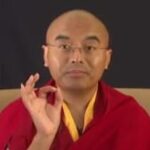
Yongey Mingyur Rinpoche is a meditation master in the Kagyu and Nyingma lineages of Tibetan Buddhism. He is the guiding teacher of the Tergar Meditation Community, a global network of meditation groups and centers. His books include Turning Confusion into Clarity and In Love with the World: A Monk’s Journey Through the Bardos of Living and Dying .

 Aliver
Aliver 







